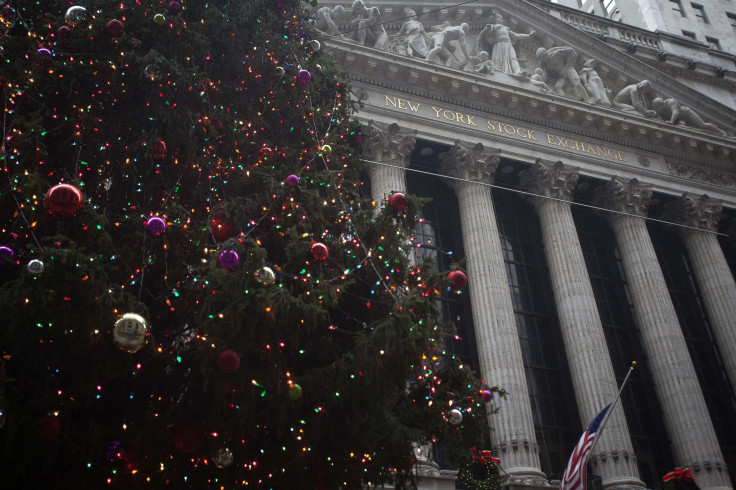Santa Claus Rally 2014: Dow Jones Industrial Average, S&P 500 Index Smash Records

U.S. stocks rallied for the sixth straight session Wednesday, with the Dow Jones Industrial Average closing at a new record high for the 37th time this year, as the official “Santa Claus Rally” kicked off. The Dow hit a fresh intraday high and closed at a new record Wednesday after the blue-chip Index smashed the psychologically important 18,000 milestone Tuesday. Meanwhile, the S&P 500 Index closed just shy of a new all-time high Tuesday, but hit a new intraday record.
U.S. financial markets closed early Wednesday ahead of the Christmas Day holiday.
The Dow, which measures the share prices of 30 large industrial companies, climbed 6.10 points, or 0.3 percent, to close at a record high of 18,030.27; the S&P 500 stock index edged down 0.29 points, or 0.01 percent, to finish at 2,081.88. The tech-heavy Nasdaq Composite added 8.05 points, or 0.17 percent, to 4,773.47.
The “Santa Claus Rally” officially got underway Wednesday, as the old saying actually refers to the last five trading days of the year and the first two trading days of the New Year, instead of the entire month of December. “It’s an old adage that if Santa Claus doesn’t come, meaning the stock market doesn’t rally, then it sets the stage for a potentially bear market in the year to come,” Karl Snyder, chief market strategist at Garden State Securities, said. “But I say we rally into the year-end.”
Keith Bliss, senior vice president and director of sales and marketing at Cuttone & Co., agrees with that bullish sentiment. “Going forward, it's certainly possible that the Dow could reach even 20,000,” Bliss said. Adding that the Dow has been, and still remains, in a bullish posture despite some of the volatility and pullbacks the Index experienced during 2014. “However, I don't think we will get there in a straight run, and you will see some volatile moves if we are going to keep eclipsing 1,000 marks in the Dow,” Bliss said.
During the previous session, the S&P 500, which tracks the share prices of the nation's 500 largest publicly traded companies, closed at a new record Tuesday for the 51st time this year, breaking its previous closing record set on Dec. 5.
“People who don’t pay attention to stocks every day hear these levels and gives them reason to either be emboldened if they’re in the market and its working, or a source of psychological stress if they’re not and they're hearing the market is grinding higher without them,” Mark Newton, chief technical analyst at Greywolf Execution Partners, said. “Technically speaking, I would say that getting over early December highs at 17,991 does give Tuesday’s move more importance as a positive, along with the S&P 500 making new all-time highs [yesterday].”
U.S. stocks continued to rise Wednesday, following Tuesday’s rally, after data revealed fewer Americans filed new claims for jobless benefits last week. Initial claims for state unemployment benefits unexpectedly dropped 9,000 last week to a seasonally adjusted 280,000, the Labor Department reported Wednesday, underscoring the fourth straight week of declines in claims.
The stronger-than-expected data follows a series of positive reports earlier this week that revealed the U.S. economy grew at its quickest pace in more than a decade last quarter, while consumer spending increased last month in the midst of the holiday shopping season. Consumer optimism has continued to pick up as global oil prices continue to hover around five-year lows, causing gasoline prices to fall at the pump. The averages price of gasoline across the U.S. is currently $2.357 per gallon, down 89.1 cents from a year ago, according to Gasbuddy.com.
Global oil prices have declined over 45 percent in the last six months, as Brent crude, the global benchmark, dropped 2.01 percent Wednesday to $60.45 a barrel, for Feb. 15 delivery, on the London ICE Futures Exchange. Meanwhile, West Texas Intermediate crude, the benchmark for U.S. oil prices, dropped 2.47 percent Wednesday to $55.71 per barrel, for Feb. 15 delivery, on the New York Mercantile Exchange.
“The economy is strong enough to absorb the risks posed by events in Russia and the possibility of another euro-zone crisis, while it is well placed to make the most of any further fall in oil prices,” Paul Ashworth and Paul Dales, economists at Capital Economics, said in a note Wednesday.
Following the U.S. Federal Reserve’s final policy meeting last week, economists eyed personal consumption expenditures (PCE) data Tuesday, or the preferred measure the central bank uses to measure U.S. inflation. The central bank replaced the phrase "considerable time" in its policy statement last week with "patient," signaling the central bank could raise interest rates sometime next year.
However, inflation continued to run below the Fed’s 2 percent target for 31st consecutive month. Data Tuesday showed the PCE Index fell 0.2 percent in November, up 1.2 percent from a year ago, but still shy of October’s annual reading of 1.4 percent, the Commerce Department said Tuesday.
But despite the lower-than-expected reading, economists still expect the central bank to maintain raising short-term interest rates, which are currently at historic lows, in the middle of 2015 if the U.S. economy continues to show strong readings on GDP and employment growth. “The data released in early January could prompt some Fed officials to decide that they can’t wait until the middle of 2015 to raise rates,” Ashworth and Dales said. "If we’re right in thinking that payroll employment rose by another 300,000 in December (data are due on Friday 9th January), some Fed officials may bring forward their preferred lift off date."
© Copyright IBTimes 2024. All rights reserved.





















